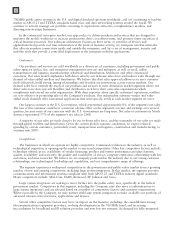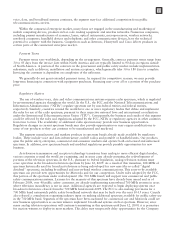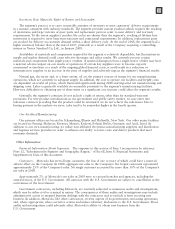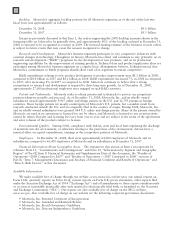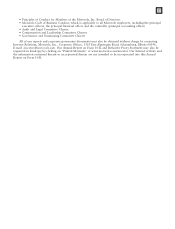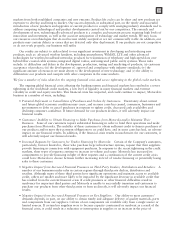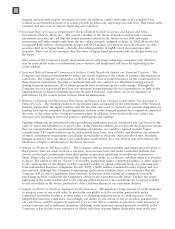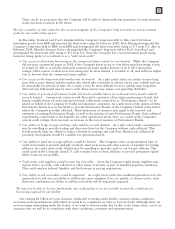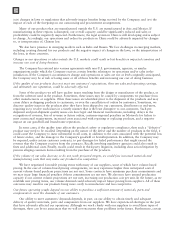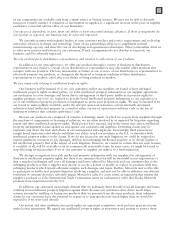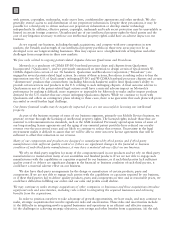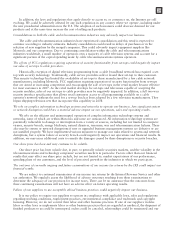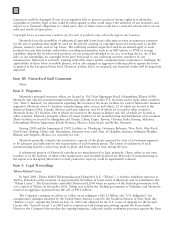Motorola 2008 Annual Report Download - page 30
Download and view the complete annual report
Please find page 30 of the 2008 Motorola annual report below. You can navigate through the pages in the report by either clicking on the pages listed below, or by using the keyword search tool below to find specific information within the annual report.
We may not generate sufficient future taxable income, which may require additional deferred tax asset valuation
allowances.
If the Company is unable to generate sufficient future taxable income in the U.S. and certain other
jurisdictions, or if there is a significant change in the actual effective tax rates or the time period within which the
underlying temporary differences become taxable or deductible, the Company could be required to increase its
valuation allowances against its deferred tax assets resulting in an increase in its effective tax rate and an adverse
impact on future operating results.
We may be required to record additional goodwill or amortizable intangible assets impairment charges, which
could result in an additional significant charge to earnings.
Under generally accepted accounting principles, we review our amortizable intangible assets for impairment
when events or changes in circumstances indicate the carrying value may not be recoverable. Goodwill is tested for
impairment at least annually. Factors that may be considered in assessing whether goodwill or intangible assets
may not be recoverable include a decline in the Company’s stock price or market capitalization, reduced estimates
of future cash flows, and slower growth rates in our industry. During 2008, the Company recorded goodwill
impairment charges of $1.6 billion and intangible assets impairment charges of $129 million. The goodwill
impairment charges resulted from lower asset values in the overall market and the impact of the
macroenvironment on the Company’s near-term forecasts. The intangible asset impairments resulted from a change
in a technology platform strategy. Further declines in the Company’s stock price, the markets or reductions in the
Company’s future cash flow estimates and future operating results may require the Company to record significant
additional goodwill or intangible asset impairment charges in our financial statements in future periods, negatively
impacting our financial results.
Our strategy to separate our businesses into two publicly-traded companies may have an adverse effect on business
operations and our assets.
The Company has announced a strategy to separate into two publicly-traded companies in the future, if and
when market and businesses conditions support a separation. There are various uncertainties and risks relating to
the proposed separation of our businesses into two publicly-traded companies, which are enhanced because we
have not announced a target date for the separation or determined the structure that will best serve the strategic
realignment. The uncertainties and risks that could have an adverse effect on our business operations or assets
include: (i) the distraction of management and disruption of operations, which could have a material adverse effect
on our operating results; (ii) perceived uncertainties as to our future direction may result in increased difficulties in
recruiting and retaining employees, particularly highly qualified employees; (iii) perceived uncertainties as to our
future direction may have a negative impact on our relationships with our customers, suppliers, vendors and
partners and may result in the loss of business opportunities; (iv) the process of exploring strategic alternatives may
be time consuming and expensive and may result in the loss of business opportunities; and (v) we may not be able
to successfully achieve the benefits of any strategic alternative undertaken by us.
Our future financial results may be negatively impacted if we do not execute on our hardware and software
strategy for our Mobile Devices business.
As part of our ongoing effort to improve the product portfolio of our Mobile Devices business, we are in the
process of rationalizing our hardware and software platforms to reduce the complexity of our product platforms
and system architecture to lower our cost to produce devices and to enable richer consumer experiences. Failure to
execute these rationalization plans in a timely and effective manner may cause us to be competitively
disadvantaged in many areas, including but not limited to, cost, time to market and the ability to ramp-up
production in a timely fashion with acceptable quality and improved/additional features.
If our operating system strategy is not successful, our Mobile Devices business could be negatively impacted.
We have made a strategic decision to use third-party and/or open source operating systems, such as Google’s
Android operating system and Microsoft’s Windows Mobile operating system in our wireless products. As a result
of this, we are at risk due to our dependency on third parties continued development of operating systems and
third parties’ software application ecosystem infrastructures. With respect to Google’s Android operating system
which is a newer operating system for wireless handsets, in the event that Google’s Android team no longer
develops the Android code base and this development is not taken up by the open source community, this would
increase the burden of development on Motorola. From an overall risk perspective, the industry is currently
engaged in an extremely competitive phase with respect to operating system platforms and software generally.
22


